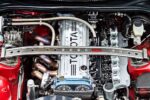Introduction
The Problem of High Crankcase Pressure in Diesel Engines
- What causes high crankcase pressure in a diesel engine?
- Why is it important to address this issue?
- What are the potential consequences of high crankcase pressure?
Diesel engines are renowned for their power and efficiency, making them the preferred choice for heavy-duty applications. However, like any mechanical system, diesel engines can experience various issues over time. One such problem is high crankcase pressure, which can have detrimental effects on engine performance and longevity.
High crankcase pressure occurs when the pressure inside the engine’s crankcase exceeds the normal operating range. This can be caused by several factors, including inadequate ventilation, worn piston rings, faulty crankcase ventilation systems, or excessive blow-by gases. Understanding the root causes of high crankcase pressure is crucial in order to address the issue effectively.
The consequences of high crankcase pressure can be severe and far-reaching. Firstly, it can lead to oil leaks as the excessive pressure finds its way out through seals and gaskets. This not only results in messy and costly oil spills but also compromises the engine’s lubrication system, leading to increased friction and wear on vital components.
Moreover, high crankcase pressure can cause oil foaming, reducing its lubricating properties and impairing the engine’s ability to dissipate heat. This can result in elevated operating temperatures, which further accelerate wear and can ultimately lead to catastrophic engine failure if left unattended.
Additionally, high crankcase pressure can negatively impact fuel efficiency. The excessive pressure can force oil mist into the intake system, contaminating the air-fuel mixture. This disrupts the combustion process, reducing power output and increasing fuel consumption. In turn, this not only hits the wallet but also contributes to environmental pollution.
In conclusion, high crankcase pressure can be a significant problem in diesel engines, with potential consequences ranging from oil leaks and increased wear to reduced fuel efficiency and engine failure. In the following sections, we will delve deeper into the causes of high crankcase pressure and explore practical recommendations to mitigate this issue effectively. It is essential to address this problem promptly to ensure optimal engine performance, longevity, and overall safety.
Understanding the Causes of High Crankcase Pressure in Diesel Engines
1. Inadequate Ventilation
One of the primary causes of high crankcase pressure in diesel engines is inadequate ventilation. The crankcase, which houses the engine’s moving parts, generates gases and vapors during operation. If the ventilation system is not functioning properly, these gases can build up and create excessive pressure within the crankcase.
Inadequate ventilation can occur due to clogged or malfunctioning crankcase ventilation filters, blocked breather tubes, or restricted airflow. When the ventilation system is compromised, the gases cannot escape efficiently, leading to increased pressure levels.
2. Worn Piston Rings
Another common culprit behind high crankcase pressure is worn piston rings. Piston rings are responsible for sealing the combustion chamber and preventing gas leakage into the crankcase. Over time, these rings can wear out, lose their elasticity, and fail to create an effective seal.
When piston rings deteriorate, combustion gases can bypass them and enter the crankcase. This phenomenon, known as blow-by, results in increased pressure within the crankcase. It is crucial to regularly inspect and replace worn piston rings to prevent high crankcase pressure and its associated problems.
3. Faulty Crankcase Ventilation Systems
A malfunctioning crankcase ventilation system can also contribute to high crankcase pressure. This system is designed to regulate the flow of gases and vapors from the crankcase to the intake manifold, where they are burned during combustion.
If the crankcase ventilation system fails to function correctly, it can lead to a buildup of gases and vapors within the crankcase. This buildup, combined with inadequate ventilation, can result in elevated crankcase pressure. Common issues with the ventilation system include clogged or stuck valves, damaged hoses, or malfunctioning PCV (Positive Crankcase Ventilation) valves.
4. Excessive Blow-by Gases
Excessive blow-by gases occur when combustion gases leak past the piston rings and enter the crankcase in large quantities. This can happen due to various reasons, such as worn piston rings, damaged cylinder walls, or excessive cylinder pressure.
When blow-by gases accumulate in the crankcase, they contribute to high crankcase pressure. It is essential to address the root cause of excessive blow-by, as it not only leads to increased pressure but also indicates potential issues with the engine’s internal components.
Conclusions
High crankcase pressure in diesel engines can stem from various factors, including inadequate ventilation, worn piston rings, faulty crankcase ventilation systems, and excessive blow-by gases. Understanding these causes is crucial in effectively diagnosing and resolving the issue.
Regular maintenance and inspection of the crankcase ventilation system, including filters, breather tubes, and valves, can help prevent inadequate ventilation and subsequent pressure buildup. Additionally, monitoring the condition of piston rings and addressing any signs of wear or damage can mitigate high crankcase pressure caused by ring-related issues.
When encountering high crankcase pressure, it is recommended to consult a qualified technician or mechanic who can diagnose the specific cause and provide appropriate solutions. Promptly addressing high crankcase pressure not only ensures optimal engine performance and longevity but also minimizes the risk of costly repairs and potential engine failure.




0 Comments